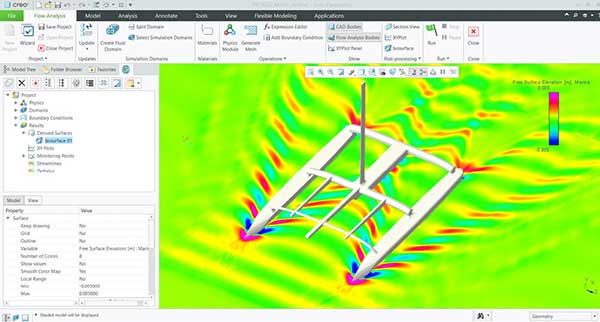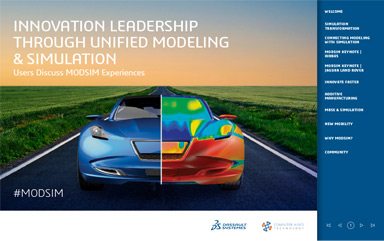
Traditional boats balance sail aerodynamics against the hydrodynamics of the hull and appendages. Now that boats fly, the hull is part of the aerodynamic system. The air flow between the hull and water is a significant new design problem and opportunity for the participants of the America’s Cup and other boat races. Image courtesy of Altair. Model created with Altair Inspire Studio, simulated with Altair ultraFluidX, and rendered with Altair Inspire Render.
Latest News
March 1, 2021
In the paper published by the American Institute of Aeronautics and Astronautics (AIAA) titled “CFD Design Studies for America’s Cup 2000,” authors Bruce Rosen, South Bay Simulations; Joseph Laiosa, Fluid Motion Analysis; and Warren Davis, Jr., AIAA member, traced the history of the use of computational fluid dynamics (CFD) in America’s Cup boat races back to the 1990s.
“CFD for yachts started to gain importance in 1983, when John Bertrand on Australia II with its high-tech winged / inverted keel took the cup from Dennis Connor on Liberty, breaking the longest winning streak in the history of sports (132 years). Technology, from any and every design aspect, was sought to bring the cup back to the U.S., and CFD benefited from that urgency. From our perspective, that movement began our involvement with the design program for Dennis Conner’s 12-meter yacht Stars and Stripes ’87. For that campaign, vortex lattice, panel codes and even some initial Navier-Stokes methods were all brought to bear on the underwater design,” the paper stated.
In the paper “CFD in Sport: a Retrospective, 1992–2012”, published by the International Sports Engineering Association (ISEA), the author R. Keith Hanna, Mentor Graphics, described CFD generally available for yacht design in the 1990s as “Simplified 3D geometries, tri[angle]/tet[rahedral] meshes, single processors; free surface & mesh-size restrictions, [completed] in weeks.”
“The level of CFD use in boat races has been increasing,” says Dr. Paul Stewart, vice president, automotive aerodynamics modeling and visualization at Altair. “Thirty or forty years ago the codes were very crude and simple. You could simulate the keel and sails, just like you would an airfoil, in steady state with simplifications.”
Mixing Water and Wind
As simulation complexity increases, so does the reliance on a higher class of hardware, offering much more capacity than personal workstations.
“In the last 10 years, the trend has been to use large compute power and study the simulation results as responses surfaces. You look at the parametric shape changes in the design space, study them statistically to see how they work together and figure out which combination works best. You can only do that for complex CFD problems with large-scale computing,” says Stewart.
“If you are simulating a small powerboat, the domain you are solving is quite small, but when you are solving for a sailing boat, where the wind really matters, you have a massive domain to solve. The atmospheric wind matters quite a lot and solving and understanding how we can best get thrust from that, needs a lot of cells. Then on top of that, you also have the water interface that you need to solve,” says Max Starr, CFD engineer for INEOS TEAM UK, a contender in the 36th America’s Cup. INEOS TEAM UK gets support from Siemens Digital Industries Software with the company’s design, data management and simulation software.
Rules Encourage Virtual Testing
To minimize cost for participants, America’s Cup organizers have prohibited tank testing, wind-tunnel testing and similar fluid dynamic testing. The AC75 Class Rule published in March 2018 puts “strict limitations on the number of components that can be built, including hulls, masts, rudders, foils and sails, thus encouraging teams to do more R&D in simulation and subsequently less physical construction and testing.” These restrictions encourage more virtual testing, usually done in CFD.
“It would have been a lot more difficult 20 years ago if we had the same rules now,” says Starr. “We can have a lot more faith in the computational models now than we could have had 20 years ago.”
“Virtual prototyping has become the way to get an advantage on the competitors and perfect the design,” notes Mark Fischer, director of product management at PTC. “HPC (high-performance computing) plays a huge role. Aside from the cluster, a competing team might have at its disposal, other cloud resources and on-demand services, like those from our partners Microsoft and AWS, [that] play an important role. They were not as abundantly available as they are now.”

PTC offers Creo Parametric, a general design program, plus Creo Simulation Live and Creo Flow Analysis to further refine the design using finite element analysis (FEA).
Riley Schutt, U.S. Sailing’s performance analyst and fluid modeling and design specialist, says the types of simulation that America’s Cup teams do usually demand HPC.
“You definitely need HPC, whether cloud services or in-house. Nimbix is the Official Compute Partner to the U.S. Sailing Team and we rely on their cloud-based computational power. I think most America’s Cup teams have in-house HPC clusters,” he remarks.
GPU’s Role in the Race
Traditional CFD is done with Navier-Stokes methods or even panel codes, typically on CPUs, according to Stewart. But the development of the Lattice Boltzmann method opened new possibilities. It was a method particularly effective with distributed computing or clusters.
“The Lattice Boltzmann code is compute-intensive, because it works out changes in very fine voxel spaces at every time step, so it takes a lot of memory,” says Stewart. “When you apply GPUs (graphics processing units) to it, it allows you to tackle large problems.”
GPU maker NVIDIA, for example, works hard to convince commercial CFD software developers to write GPU-accelerated codes in its compute unified device architecture programming environment. Ansys Fluent is one example of GPU acceleration, and has model flow, turbulence, heat transfer and reactions for industrial applications.
“Ansys Fluent runs up to 3.7X faster on GPUs, dramatically reducing time to solution from weeks to days,” NVIDIA states.
However, not all simulation tasks can benefit equally from the GPU.
“CFD codes do not scale very well on GPUs, especially when you are simulating both water and air,” says Starr. Starr and his colleagues from INEOS TEAM UK use Siemens’ Simcenter STAR-CCM+ software for CFD.
No Free Lunch in the Virtual World
Virtual tests and simulation cost much less than building physical mockups and conducting tank testing, but the process still exacts a toll—in time and computing cycles.
“The whole setup involves taking the CAD model of your design idea, to creating a surface mesh, and then the volume mesh around that [to represent the air and water interacting with the boat]—that’s just preprocessing. Then you have the simulation itself,” explains Stewart.
“In comparison, it might take 6 to 12 hours to run a 2-second simulation for a full car. The transient simulation of the flow fields for a 2-second event can produce half a terabyte of data. If you do 10 or 20 runs [for design variations], having the compute power to consume that much data is important,” Stewart says.
“When we use CFD in the America’s Cup, although we do have a lot of repetitive simulations, there are a lot of one-off simulation studies as well. Especially now, with this unique and new class of boat, we are still trying to understand that as well. That means there are a lot of one-off what-if studies that we will do. You do want to have a standard library of simulations just to churn through different designs and different scenarios,” he adds.
Hanna, the author of the paper “CFD in Sport” (ISEA), points out that in 2012, CFD for yacht design had improved to allow “Full 3D models, HPC, supercomputers, moving hybrid mesh, overtaking, free surface, [results] in days.”
That’s much better than the weeks it took in the 1990s to get the results, but with the clock ticking away before the race, the number of days available to explore different ideas, commit to a specific concept, then manufacture the boat, is finite.
More Altair Coverage
More Ansys Coverage
More PTC Coverage
More Siemens Digital Industries Software Coverage
Subscribe to our FREE magazine, FREE email newsletters or both!
Latest News
About the Author
Kenneth Wong is Digital Engineering’s resident blogger and senior editor. Email him at kennethwong@digitaleng.news or share your thoughts on this article at digitaleng.news/facebook.
Follow DE





